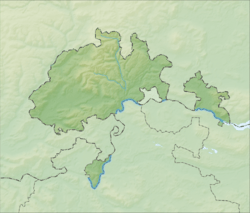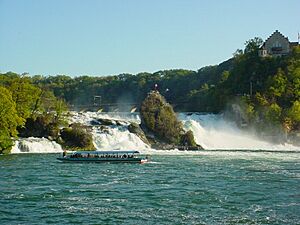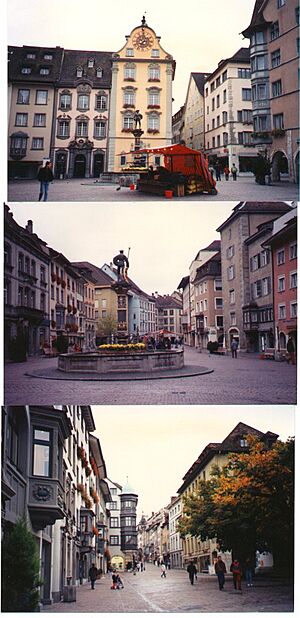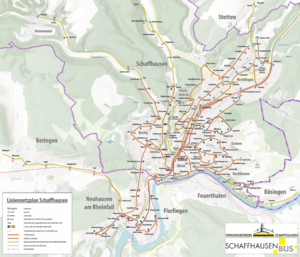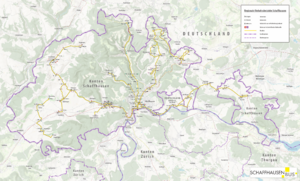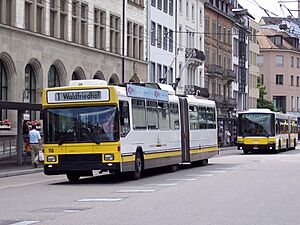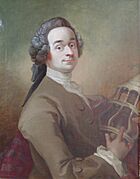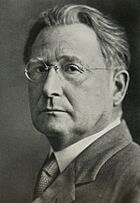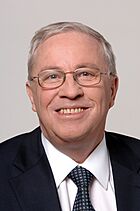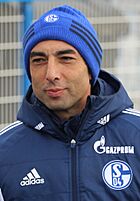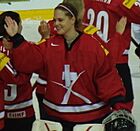Schaffhausen facts for kids
Quick facts for kids
Schaffhausen
|
||
|---|---|---|
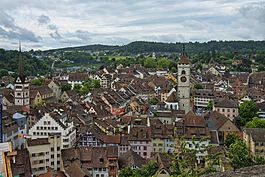
Schaffhausen in 2012
|
||
|
||
| Country | Switzerland | |
| Canton | Schaffhausen | |
| District | (None in canton of Schaffhausen) | |
| Area | ||
| • Total | 41.85 km2 (16.16 sq mi) | |
| Elevation
(Bahnhofstrasse)
|
403 m (1,322 ft) | |
| Population
(Dec 2020 )
|
||
| • Total | 36,952 | |
| • Density | 882.96/km2 (2,286.86/sq mi) | |
| Postal code |
8200, 8203, 8207, 8208, 8231 Hemmental
|
|
| Localities | Schaffhausen, Breite, Gruben, Buchthalen, St. Niklausen, Herblingen, Hauental, Hemmental | |
| Surrounded by | Beringen, Büsingen am Hochrhein (DE-BW), Büttenhardt, Dörflingen, Feuerthalen (ZH), Flurlingen (ZH), Merishausen, Neuhausen am Rheinfall, Stetten, Thayngen | |
| Twin towns | Sindelfingen (Germany), Singen am Hohentwiel (Germany), Dobrich (Bulgaria) | |
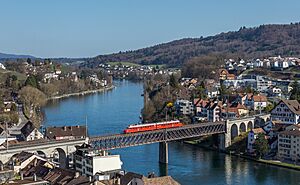
Schaffhausen is a historic town and municipality in northern Switzerland. It is the capital of the canton of the same name. The town is located right next to the High Rhine river. It is one of only four Swiss towns on the northern side of the Rhine.
The old town of Schaffhausen has many beautiful buildings from the Renaissance period. These buildings are often decorated with cool paintings called frescos and sculptures. You can also find the old canton fortress, the Munot, here.
Schaffhausen is an important railway hub, connecting Swiss and German train networks. One of the train lines links the town to the famous Rhine Falls. This is Europe's largest waterfall and a very popular place for tourists to visit.
The official language spoken in Schaffhausen is German. However, most people speak a local dialect called Swiss German.
Contents
What's in a Name?
The town was first mentioned in history in 1045 as Villa Scafhusun. There are two main ideas about where this name came from.
- One idea connects the name to a "ford" across the Rhine river, mentioned in 1050. A "ford" is a shallow place where you can cross a river. This might have been a scapha, which is a type of small boat or skiff. These boats were used to move goods around the Rhine Falls. So, the name Scafhusun could have come from the scapha used there.
- Another idea is that Scafhusun comes from the word Schaf, which means "sheep" in German. An image of a ram (a male sheep) was the old symbol for the town, dating back to 1049. This symbol came from the town's founders, the counts of Nellenburg.
Town Symbol: Coat of Arms
The coat of arms for Schaffhausen shows a golden shield with a green base. From the left side of the base, a silver castle with a tower appears. A black ram is coming out of the castle's entrance. This symbol, with the sheep, supports the idea that the town's name comes from "sheep-house."
A Look Back in Time
Schaffhausen was a city-state during the Middle Ages. It even made its own coins starting in 1045. Around 1050, the counts of Nellenburg started the Benedictine monastery of All Saints. This monastery became the heart of the town.
By 1190, and definitely by 1208, Schaffhausen was a free city of the Holy Roman Empire. This meant it was directly under the emperor's rule, not a local lord. The first official seal of the town dates back to 1253. Over time, the power of the abbot (the head of the monastery) became less. In 1277, Emperor Rudolf I gave the town more freedoms.
In 1330, Emperor Louis of Bavaria gave the town to the Habsburgs. But in the early 1400s, the Habsburgs' control over the city weakened. In 1349 and 1401, sad events called pogroms happened in the city. By 1411, different guilds (groups of skilled workers) were running the city.
Then, in 1415, the Habsburg Duke Frederick IV of Austria supported a rival pope at the Council of Constance. Because of this, the Emperor Sigismund banned him. This situation, along with Frederick needing money, allowed Schaffhausen to buy its independence from the Habsburgs in 1418.
The city then made alliances with six of the Swiss confederates in 1454. It allied with two more, Uri and Unterwalden, in 1479. Finally, Schaffhausen became a full member of the Old Swiss Confederacy in 1501.
The Reformation began in Schaffhausen in 1524 and was fully adopted by 1529. The town faced a lot of damage during the Thirty Years' War. This was due to different armies passing through and the important bridge being burned down. It took until the early 1800s for the town's industrial growth to start again. In 1857, the first railroad reached Schaffhausen from Winterthur.
Schaffhausen is located in a part of Switzerland that is almost surrounded by Germany. On April 1, 1944, during World War II, Schaffhausen was bombed by planes from the United States Army Air Forces. The planes had flown into neutral Switzerland by mistake. Air raid sirens had often sounded before without an actual attack, so many residents did not take cover. Sadly, some people lost their lives in the attack. The President of the United States, Franklin Delano Roosevelt, sent an apology. The United States also quickly offered money to help the town recover.
Where is Schaffhausen?
Land and Location
The town of Schaffhausen sits on the right bank of the Rhine river. It covers an area of about 41.85 square kilometers. About 20.2% of this land is used for farming. A large part, 53.4%, is covered by forests. The rest of the land is used for buildings and roads (24.8%) or is unproductive (1.6%).
Over the last 20 years, the amount of land with buildings has grown. The amount of farmland has decreased.
Schaffhausen has grown over time by merging with nearby villages. In 1947, it merged with Buchthalen. In 1964, Herblingen joined. And in 2009, Hemmental became part of the municipality.
The town also shares a border with a German village called Büsingen am Hochrhein. This village is a special case because it is completely surrounded by Switzerland.
Weather in Schaffhausen
Schaffhausen usually has about 122.5 days of rain or snow each year. On average, it gets about 907 millimeters (35.7 inches) of rain or snow. July is the wettest month, with about 95 millimeters (3.7 inches) of rain over 11.3 days. February is the driest month, with about 59 millimeters (2.3 inches) of rain over 8.4 days.
| Climate data for Schaffhausen (Reference period 1991–2020) | |||||||||||||
|---|---|---|---|---|---|---|---|---|---|---|---|---|---|
| Month | Jan | Feb | Mar | Apr | May | Jun | Jul | Aug | Sep | Oct | Nov | Dec | Year |
| Mean daily maximum °C (°F) | 3.3 (37.9) |
5.4 (41.7) |
10.7 (51.3) |
15.4 (59.7) |
19.5 (67.1) |
23.1 (73.6) |
25.1 (77.2) |
24.6 (76.3) |
19.7 (67.5) |
14.0 (57.2) |
7.5 (45.5) |
3.8 (38.8) |
14.3 (57.7) |
| Daily mean °C (°F) | 0.7 (33.3) |
1.7 (35.1) |
5.8 (42.4) |
9.9 (49.8) |
14.0 (57.2) |
17.6 (63.7) |
19.3 (66.7) |
18.8 (65.8) |
14.5 (58.1) |
9.8 (49.6) |
4.7 (40.5) |
1.5 (34.7) |
9.9 (49.8) |
| Mean daily minimum °C (°F) | −1.7 (28.9) |
−1.6 (29.1) |
1.5 (34.7) |
4.7 (40.5) |
8.9 (48.0) |
12.4 (54.3) |
14.1 (57.4) |
13.9 (57.0) |
10.2 (50.4) |
6.4 (43.5) |
2.1 (35.8) |
−0.9 (30.4) |
5.8 (42.4) |
| Average precipitation mm (inches) | 72 (2.8) |
60 (2.4) |
64 (2.5) |
68 (2.7) |
100 (3.9) |
95 (3.7) |
103 (4.1) |
95 (3.7) |
72 (2.8) |
77 (3.0) |
73 (2.9) |
86 (3.4) |
966 (38.0) |
| Average snowfall cm (inches) | 17.6 (6.9) |
17.1 (6.7) |
5.6 (2.2) |
0.8 (0.3) |
0.0 (0.0) |
0.0 (0.0) |
0.0 (0.0) |
0.0 (0.0) |
0.0 (0.0) |
0.0 (0.0) |
5.1 (2.0) |
11.0 (4.3) |
57.2 (22.5) |
| Average precipitation days (≥ 1.0 mm) | 10.2 | 8.7 | 10.0 | 9.4 | 11.3 | 10.9 | 11.4 | 10.8 | 8.9 | 10.5 | 9.9 | 11.1 | 123.1 |
| Average snowy days (≥ 1.0 cm) | 5.1 | 5.3 | 2.2 | 3.6 | 0.6 | 0.0 | 0.0 | 0.0 | 0.0 | 0.0 | 1.7 | 4.2 | 19.0 |
| Average relative humidity (%) | 84 | 79 | 72 | 66 | 69 | 69 | 69 | 72 | 78 | 84 | 86 | 86 | 76 |
| Mean monthly sunshine hours | 42 | 76 | 130 | 165 | 182 | 204 | 221 | 205 | 151 | 88 | 43 | 33 | 1,540 |
| Percent possible sunshine | 19 | 31 | 42 | 46 | 46 | 50 | 54 | 55 | 47 | 31 | 18 | 16 | 41 |
| Source: MeteoSchweiz (snow 1981–2010) | |||||||||||||
People and Life in Schaffhausen
Who Lives Here?
Schaffhausen has a population of about 36,000 people. As of 2014, about 27.9% of the people living here are foreign nationals. Many of these come from Germany, Italy, Croatia, and Serbia.
Most people in Schaffhausen speak German (84.3%). Serbo-Croatian is the second most common language (3.4%), followed by Italian (3.2%).
From 2010 to 2014, the population grew by about 2.82%. In 2014, for every 1,000 residents, 9.6 babies were born and 10.1 people passed away.
In 2014, children and teenagers (0–19 years old) made up 17.8% of the population. Adults (20–64 years old) were 61.7%, and seniors (over 64 years old) were 20.5%.
Learning and Schools
In Schaffhausen, about 69.8% of adults (aged 25–64) have finished high school or gone on to higher education. This includes university or a university of applied sciences.
As of 2007, about 1.73% of the population attends kindergarten or pre-school. About 5.65% attend Primary School. Another 2.98% attend a lower level Secondary School, and 2.49% attend a higher level Secondary School.
How People Work
In 2013, there were over 25,700 jobs in Schaffhausen.
- A small number of people (103) worked in the primary economic sector, which includes farming.
- About 6,400 people worked in the secondary sector. This includes manufacturing and industry.
- The largest number of jobs, over 19,200, were in the tertiary sector. This sector includes services like shops, restaurants, and offices.
In 2015, hotels in Schaffhausen had over 102,500 overnight stays. More than half of these visitors were from other countries. The town also has two movie theaters with a total of 10 screens. There are 102 restaurants and 11 hotels.
Getting Around Schaffhausen
Train Travel
Schaffhausen has two train stations: Schaffhausen railway station and Herblingen railway station.
Schaffhausen railway station is shared by the Swiss Federal Railways (SBB) and German Rail (DB). Trains from both countries use this station. You can catch long-distance trains to places like Stuttgart and Zürich. There are also regional trains and local S-Bahn services. The S24 S-Bahn line offers a direct connection to Zürich Airport.
Herblingen railway station is in the north-east of Schaffhausen. It is served by the S24 S-Bahn and local trains that connect to nearby towns.
Bus Services
Schaffhausen and the nearby town of Neuhausen am Rheinfall have a city bus network with 8 lines. This includes the Schaffhausen trolleybus system (line 1). Since 2019, many buses are electric. Most bus routes stop at Schaffhausen railway station.
There are also regional bus services. These buses connect Schaffhausen to villages in the canton of Schaffhausen, the canton of Zürich, and even nearby German areas.
| Line | Route |
|---|---|
| 1 | Herbstäcker – Neuhausen Zentrum – Schaffhausen railway station – Ebnat – Waldfriedhof |
| 3 | Sommerwies – Schützenhaus – Schaffhausen railway station – Krummacker |
| 4 | Birch – Schützenhaus – Schaffhausen railway station – Gruben |
| 5 | Schaffhausen railway station – Falkeneck – Einkaufszentren – Schlossweiher |
| 6 | Buchthalen – Schifflände – Rhybadi / IWC – Schaffhausen railway station – Kantonsspital – Falkeneck |
| 7 | Neuhausen SBB – Neuhausen Zentrum – Schützenhaus – Schaffhausen railway station |
| 8 | Schaffhausen railway station – Schifflände – Im Freien |
| 9 | Ebnat – Kinepolis – Herblingen railway station – Einkaufszentren |
Boat Trips
From the Schifflände area, you can take boat trips on the Rhine river. These trips go to Stein am Rhein and Kreuzlingen on Lake Constance. They are offered during the warmer months of the year.
Driving in Schaffhausen
The A4 motorway connects Schaffhausen to Zürich. The A4 also continues north into Germany. Since 1996, the A4 goes through a tunnel, so it bypasses the town center. There are three exits from the A4 near Schaffhausen.
The Hauptstrasse 13 is another main road. It connects Schaffhausen to villages in the western part of the canton. It also links to villages along the Rhine River to the east.
Culture and History
Important Heritage Sites
Schaffhausen has 35 buildings or sites that are considered heritage sites of national significance. This means they are very important to Switzerland's history and culture.
These sites include:
- The entire old town of Schaffhausen.
- The old city walls.
- The Giesserei +GF+ Werk I factory.
- The town and cantonal archives.
- The Schweizersbild Paleolithic cave, which is a very old cave.
- The Herblingen and Grüthalde Neolithic settlements, which are ancient villages.
- Four former guild houses and seven special houses.
- Two religious buildings: the former Benedictine All Saints Abbey and the Church of St. John.
Economy and Business
Schaffhausen is home to several well-known companies.
- Georg Fischer makes piping systems, machine tools, and car parts.
- IWC is a famous company that makes watches.
- Cilag is a pharmaceutical company.
- BB Biotech works in biotechnology.
- Other companies like Tyco International, Garmin, and Acronis (a cyber protection company) also have offices here.
Sports in Schaffhausen
Schaffhausen has two football (soccer) teams:
- SV Schaffhausen, which plays in the fourth-tier Swiss 1. Liga.
- FC Schaffhausen, which plays in the second-tier Swiss Challenge League.
They play at the Breitestadion, which can hold 4,200 people. This stadium is also used for training local children's football teams.
There is also a handball team called Kadetten Schaffhausen. They play in the top Swiss division. Their home is the BBC Arena, which opened in 2011 and can seat 3,600 people. Kadetten Schaffhausen has won many titles and is one of the most successful teams in the history of the SHL.
Famous People from Schaffhausen
Many interesting people have come from Schaffhausen, including:
- Johann Jakob Wepfer (1620–1695), a doctor who studied diseases and medicines.
- George Michael Moser (1706–1783), an artist who helped start the Royal Academy in London.
- Johann Jakob Schalch (1723–1789), a painter famous for his pictures of the Rhine Falls.
- Johann Conrad Fischer (1773–1854), an inventor and pioneer in the steel industry. He founded Georg Fischer AG.
- Hermann Rorschach (1884–1922), a psychiatrist who developed the famous Rorschach inkblot test.
- Walther Bringolf (1895–1981), who was the mayor of Schaffhausen for many years.
- Conrad Beck (1901–1989), a composer.
- Christoph Blocher (born 1940), a well-known politician and businessman.
- Irène Schweizer (born 1941), a famous jazz pianist.
- Roberto Di Matteo (born 1970), a former professional football player and team manager.
- Florence Schelling (born 1989), an ice hockey goalie and Olympian. She was the first woman to be a general manager for a professional men's hockey team.
See Also
 In Spanish: Schaffhausen para niños
In Spanish: Schaffhausen para niños




